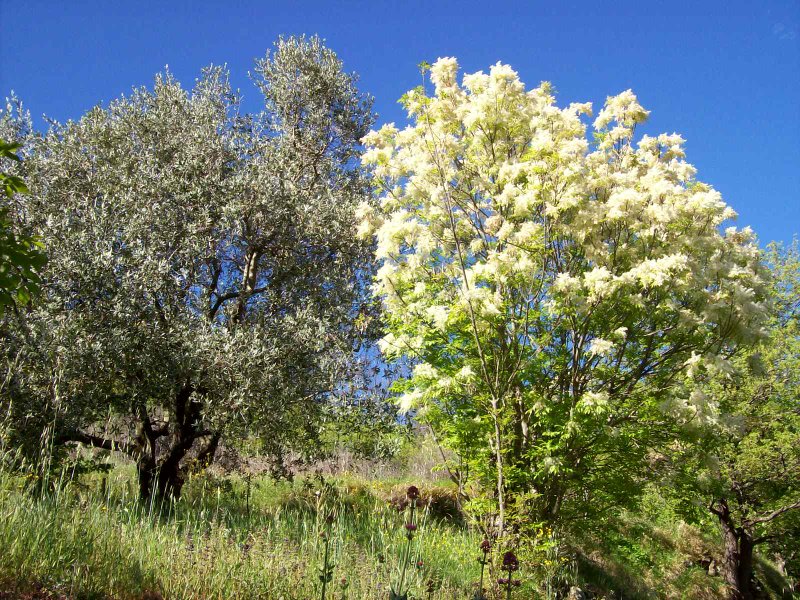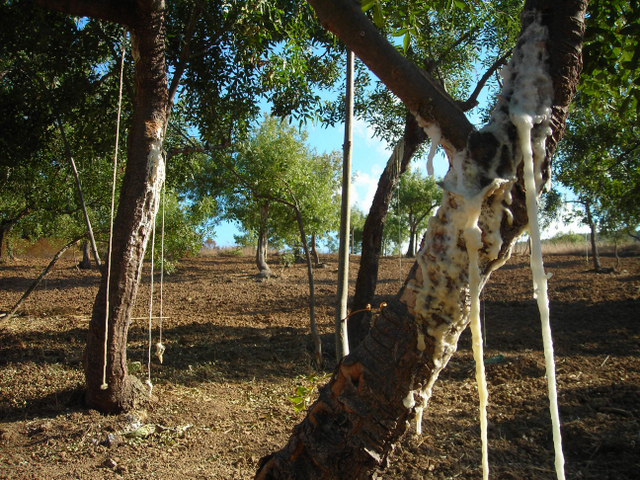Manna From Italy Posted by Geoff on May 4, 2016 in Culture
It would be a wild understatement to say that when I first moved to Lunigiana in Italy I encountered a ‘steep learning curve’. Apart from dealing with the many linguistic and cultural challenges, I also became aware that my new habitat held a vast array of flora and fauna pretty much unknown to me.
Growing up surrounded by nature in a little village in the English countryside, I knew the names of a wide variety of plants and animals. But here I found species not native to my Northern Europe ‘playground’, and hence I became a child all over again, learning the names, and often the uses of many unfamiliar plants.
During my first spring in Valdantena, one such plant announced its presence to me with an impressive dense mane of creamy white flowers: il frassino da manna (the manna ash).

This photo, taken close to my home in Lunigiana, was included in last week’s quiz. On the right: a frassino da manna displays its distinctive creamy white mane of flowers.
Ancient Origins
Yet it isn’t the profusion of flowers that carpet the ground like snow when they fall that gives the tree its name, but the sweet sap which is extracted by the frassinicoltore (manna ash cultivator).
The ancient Greeks and Romans, who harvested this sap for its healing properties, called it ‘secrezione delle stelle’, (literally: secretions of the stars) or ‘miele rugiada’ (honeydew). But it was probably the Arabian pharmacists who first called it manna, partly for its miraculous curative properties, but also for its appearance, which brought to mind the biblical manna. In fact, il frassino da manna was first introduced to Sicilia whilst the region was under Arabic domination between the 9th and 10th centuries A.D.
A Disappearing Tradition
At one time, the harvesting of manna was an important agricultural activity in many parts of the Italian peninsula. But since the introduction of industrial alternatives, and the abandonment of the countryside in favour of the cities, this fascinating and surprisingly complex tradition has all but died out. The art of harvesting manna has been passed down through generations from father to son, and there is very little accurate written documentation on it. Today, it is vital that young people are initiated into its ways before it becomes yet another lost craft.
In the following video, Giulio Gelardi, widely recognised as Italy’s leading expert in the cultivation and harvesting of il frassino da manna, talks with great passion, intelligence, and more than a little philosophical intuition about the tradition of the frassinicoltore (manna ash cultivator). You may have trouble following what Signor Gelardi says, but don’t worry, well be posting translated extracts from the video later in the week.
Medicinal and Culinary Uses
Manna is used as a digestive, a light laxative, and a cough remedy. Its sweet flavour is reminiscent of honey or sugar cane, and it makes an excellent and safe sugar substitute for diabetics.
Manna is also used in pastry making and cosmetics. These days it is protected by the Slow Food Association, which promotes traditional gastronomy.
Per Saperne Di Più
If you’d like to know more about the cultivation and uses of manna you may find the following websites useful:
www.ilfrassino.it
passion4sicily
Have you ever tried manna? Please share your experience.

Build vocabulary, practice pronunciation, and more with Transparent Language Online. Available anytime, anywhere, on any device.





Comments:
Julie:
Molto interesante! Conosco l’albero ma non avevo idea della storia. Grazie!
paolo minotto:
Grazie. Non sapevo di questo albero né la coltura di manna.
Jo Sheldon:
Reminiscent of the way Rubber Trees were “milked” to obtain rubber in Malaysia. Also collecting sap from trees to make wine.
Maman. X
Mike Nicolucci:
È veramente stupendo quello video su molti livelli.
Geoff:
@Mike Nicolucci Hai ragione Mike … stupendo è la parola giusta! E’ stato molto interessante per me fare la ricerca.
A presto, Geoff 🙂